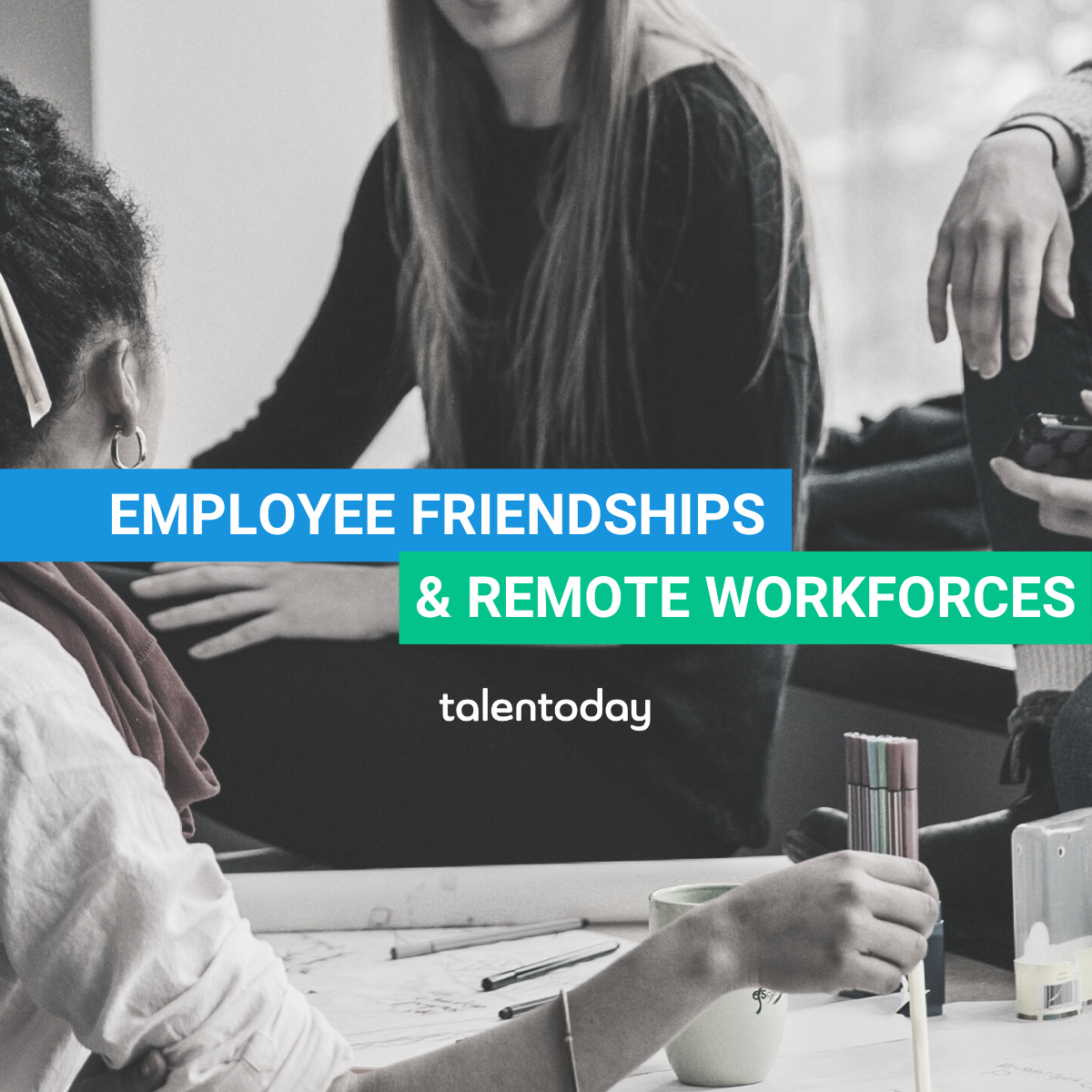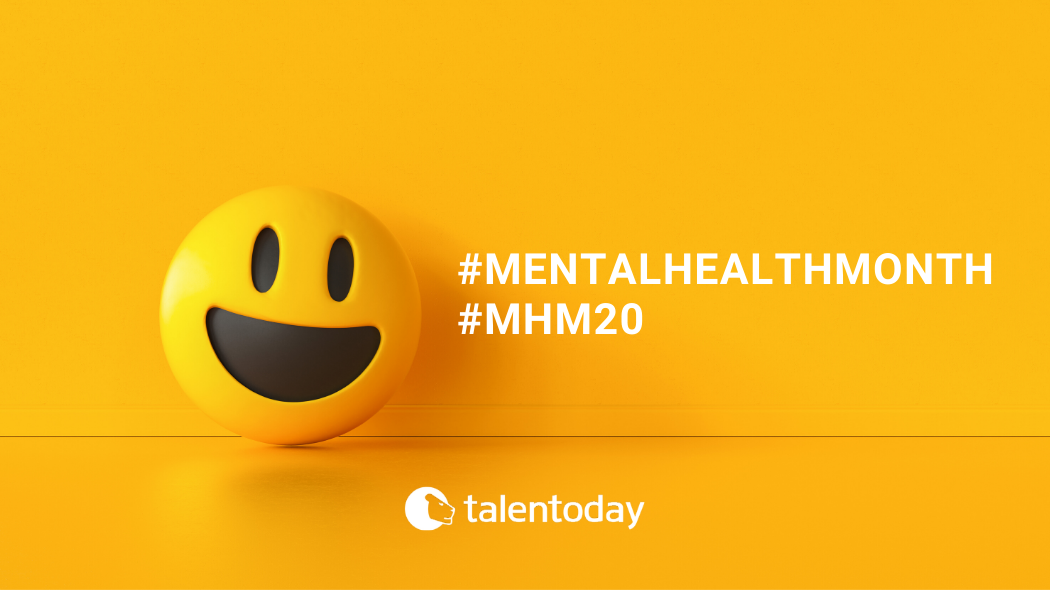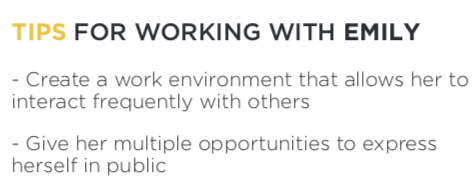Employee Friendships in 2020

If you’re like me, you’re probably missing your work friends right now. Even if you’re not like me there’s still a pretty high chance of that! Millions of people around the world have been working from home amidst the COVID-19 pandemic, and working in pajamas has become the new normal… okay, maybe not everyone is in pajamas.
Even though we might not be seeing our work pals it is important to find ways to stay connected. A study by Gallup¹ found that workplace friendships are one of the strongest predictors of productivity. In addition, those who have strong work relationships are more engaged, produce higher-quality work, and have an overall higher state of well-being. That same study found that in order to have a thriving day we need at least six hours of social time. Sound impossible? It’s not as difficult as you might think.
The ‘New Normal’
With the ‘new normal’ in the workplace including remote work, social distancing procedures, alternating schedules, and other obstacles that make our social interactions more difficult to achieve, we need to be more intentional about our workplace friendships. These challenges are something that every company is learning to navigate, and it does not have to come at the expense of employee relationships and well-being.
A study done in New Zealand after a series of earthquakes forced many people to move into remote working found that the biggest area of concern to employees was the social cost². This included professional and personal isolation, limited team interaction, loss of visibility and development, and lack of face-to-face communication. Thankfully we live in an age where technology can be our friend and counteract a lot of these concerns!
Zoom, Zoom, Zoom!
Raise your hand if you have used Zoom in the past month. There have been between 200–300 million daily meeting participants on Zoom during the beginning months of COVID-19³. Birthday parties, happy hours, book clubs, classes, and business meetings are just a few of the many social gatherings that have turned virtual in 2020. Leveraging video conferencing can help bring employees together as well!
Do you normally eat lunch with your coworkers every day? Maybe pick one day each week to have a ‘virtual lunch’ with those that you’d normally (or not normally) eat with. Even a quick instant message to your work buddies to ask a question, or simply share what you’ve been binge watching on Netflix, can help add to that six hours of social time needed for a thriving day!
Working in a virtual environment also gives employees the opportunity to reach out to those that they would not normally have the opportunity to work with. Whether it is collaborating on a project with individuals in other offices or departments, or simply reaching out to colleagues to get to know them better, the virtual workplace gives everyone a chance to create new connections that aren’t determined by physical proximity.
MyPrint® for the Virtual Age
With virtual and remote teams being the new normal, it might take a little more creativity to bring your team together! Some fun events that we at Talentobe have done to stay connected are virtual happy hours, knowledge sharing sessions from different departments, and a MyPrint® ‘Guess Who’ game!
As new teammates are being onboarded into a virtual workplace, it can be difficult to get to know each other in the same way you would when meeting face-to-face. You can help to jumpstart these new workplace connections by leveraging a lot of the tools that the MyPrint® assessment provides! Sharing your dominant personality traits, learning how to motivate one another, or reading through your Collaboration Report together can help alleviate some of the pains that come with a virtual working relationship.
No matter what your new normal looks like, whether it is back in the office or in your pajamas at home, MyPrint® can help you and your team to continue to adapt and grow together!
Looking for additional resources and support? Email Talentobe at customer@talentobe.com to learn more about activities like the MyPrint ‘Guess Who’ game and other services!
References
¹ Rath, T. & Harter, J. (2010). Your friends and your social well-being.
Business Journal.
https://news.gallup.com/businessjournal/127043/friends-social-wellbeing.aspx
² Donnelly, N. & Proctor-Thomson, S. B. (2015). Disrupted work: Home-based teleworking (HbTW) in the aftermath of a natural disaster. New Technology, Work and Employment, 30(1), 47–61. https://doi.org/10.1111/ntwe.12040
³ Iqbal, Mansoor (2020). “Zoom Revenue and Usage Statistics (2020).” Business of Apps, www.businessofapps.com/data/zoom-statistics/.
Prioritizing Well-being with Psychometrics

Circa 2019, well-being and soft skills were hot topics of discussion around personal growth and internal fulfillment. However, as we moved into 2020, individuals had new norms to navigate, from social isolation, economic stress, and round-the-clock news coverage for the COVID-19 pandemic. Anytime someone goes through a change, it’s not uncommon for anxiety and stress to increase, and this pandemic is no exception. Based on a study completed by Inpulse, featured in Four Ways Leaders Can Support Anxious And Lonely Teams¹, in mid-April 2020, research found that 65% of employees have felt nervous, anxious or on edge, and 43% have not been able to stop or control worrying. Further, pre-COVID19 pandemic, it was found that people with depression have a 40% higher risk of developing cardiovascular and metabolic diseases than the general population, and globally, depression is the leading cause for disability². For individuals, the ability to identify depression, anxiety or stress plays a critical role in managing their well-being. Luckily, individuals aren’t alone in this, as psychometrics and technology are here to help!
Understanding yourself
Simply put, your well-being is the level at which you feel comfortable, happy and healthy³. The tricky thing about well-being is there’s often more than meets the eye. As humans, everyone is unique in how they interpret their anxiety (or stress), and they’re unique in how they make time — assuming they do — to address their mental and physical health challenges. For many, it’s often easy to prioritize work, family and other responsibilities over one’s own well-being, but that doesn’t make it a healthy or sustainable practice. With the use of technology, companies like HealthPersonas and Talentobe are leveraging psychometrics to uncover the obstacles a person is dealing with and empower them with their soft skill strengths. In both cases, the overall goal is to help individuals increase their level of self-fulfillment, and ultimately their well-being.
Prioritizing your well-being
Now more than ever, psychometrics have the ability to positively impact us and those around us. Even for the most selfless people, taking care of those around you means taking care of yourself first. We are all aware being healthy is more than just physical. HealthPersonas measures and improves emotional and behavioral health, the way we feel and think, taking a well-being approach to healthcare and unlocking personalized results along the way. A key component of HealthPersonas success is their KnowMe™ assessment, which was developed in partnership with Talentobe. KnowMe™ offers a fun user experience that allows individuals to quickly identify what makes us unique and how to best seek health and happiness. To complement the KnowMe™ findings, HealthPersonas offers an engaging mobile experience by providing emotional health support with both chat and video-based expert coaching.

HealthPersonas founder, Alex Bitoun, has worked in healthcare delivering chronic care programs to self-funded employers and health plans for the past 15 years. Alex notes, “Emotional health is a key component to overall health, and is too often ignored in the current care paths. By focusing our efforts on how our members feel, we not only improve their well-being, but we are unlocking clinical results that had eluded them in the past.”
Lean into your uniqueness
Just like each person is unique in how they interpret and respond to adversity, everyone is unique in their personality and motivations. When faced with a challenge, we may see how our personality traits and motivations work together to either lift us up, or potentially bring us down. Although there’s a number of things that we can’t control, through understanding our dominant personality traits and motivations, we can make the choice to create a comfortable environment that corresponds to our needs and increases our overall well-being. Through Talentobe’s soft skill assessment, MyPrint®, we leverage psychometrics to empower individuals to understand not only what their dominant personality and motivation traits are, but we also provide guidance on what environments (or actions) will allow them to hone in on their strengths and fulfill their needs. Through having these personalized insights at your fingertips, you can make incremental changes in your daily routine, work style or relationships, to increase your sense of self-fulfillment and even share results with those that you collaborate with most often for additional support.

Expanding your reach
With about half of employees feeling some form of anxiety, worry or sadness, odds are someone close to you is battling some degree of discomfort during this time. With social isolation changing how we interact with people, from limited (or no) in-person conversations to hugging our family, individuals have been relying on technology to create a sense of connection. As a number of people leverage FaceTime, Zoom and other communication platforms, psychometrics-based technology opens the door for a new type of collaboration. Whether it’s sharing your insights with those around you, encouraging them to do the same, or utilizing virtual health services (like those offered by HealthPersonas) you’re empowering the people close to you by removing stigmas associated with well-being and mental health support, while providing them tangible solutions. Similar to how you have to prioritize your own well-being to achieve the positive impact of these digital solutions, you have to encourage those close to you to do the same.
The concept of well-being, seemingly simple when you break it down to its most basic parts — happiness, health and comfort — is anything but simple when you think of the uniqueness and complexities of each individual. Luckily, both the technology and psychometrics used are equally as complex behind the scenes, while providing easy to understand solutions to the end user. For individuals ready to prioritize themselves, even if it’s just for an hour a day, you can get started by taking both the KnowMe™ and MyPrint® assessments. Both assessments can be completed totally free of charge and will give you access to your individual insights, enabling you to put your well-being front of mind.
Looking for additional resources and support for mental health? See National Alliance on Mental Health (https://www.nami.org/home) and Mental Health Foundation (https://www.mentalhealth.org.uk/).
For more information on Talentobe visit our company website or you can reach out to us directly at contact@talentobe.com.


